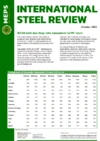Year of the Dragon may not fire-up Asian steel market
East Asia’s steel market participants appeared unlikely to benefit from the Year of the Dragon’s ‘luck and prosperity’ as market activity resumed following the Lunar New Year celebrations.
Many MEPS International research respondents who discussed their post-festival expectations in February’s International Steel Review believe their fortunes in 2024 could prove to be very different. There is currently little expectation of any noticeable market recovery.
Prolonged demand weakness
East Asia’s market for both flat and long products has experienced a prolonged period of demand weakness. Low booking activity, high inventories and reduced export sales to other parts of the world were common features for much of 2023.
At the start of January, Chinese, South Korean and Taiwanese steelmakers increased their price quotations as they came under pressure from rising raw material costs. Many businesses in the steel sector undertook a short period of restocking to cover their post-Lunar New Year requirements. East Asian prices rallied, briefly. This proved something of a false dawn, however.
Unsure of their ability to pass on higher costs further down their supply chain, many regional distributors ended their buying activity, adopting a “wait and see” approach. Little trading activity was reported in the run-up to February’s holiday period.
Furthermore, many Chinese-related companies either scaled down their business activities or made plans not to reopen until the latter part of February.
With those celebrations now coming to an end, East Asian purchasing managers will be looking for signs of the traditional post-Lunar New Year boost. Historical price patterns suggest that East Asian prices typically increase as demand rises following the annual festivities.
In 2024, a continuation of this trend is far from certain. Any potential rise in market demands, or spike in prices, could prove to be short-lived.
There are a number of reasons for this: end-user demand in all East Asian countries remains fundamentally weak; steel consumption is unlikely to improve to any great extent during the course of the year; and recent economic data indicates an uncertain outlook.
East Asia’s subdued outlook
China’s economy grew by 5.2% last year. This latest estimate is below original projections. Growth in 2024 is already predicted to slow further.
Ongoing concerns surrounding China’s property sector persist. The collapse of property developer Evergrande may be a sign of deeper issues. Further real estate-related problems are likely to be a major drag on the country’s economy.
Infrastructure spending may also be curbed by the Chinese government. A recent directive was issued to some Chinese provinces to halt state-funded projects because of financial concerns.
China's neighbouring countries face their own challenges.
In mid-February, figures released by the Japanese Cabinet Office confirmed that Japan had unexpectedly fallen into a recession. Its GDP declined by 0.4% in quarter four of last year, following a 3.3% decline in the previous quarter. Modest growth is predicted this year.
South Korea’s GDP grew by 0.6% in quarter four of 2023. However, a similar, modest rate of GDP growth to Japan is projected for 2024 following a recent economic downgrade by the Bank of Korea.
Conversely, the economic outlook for Taiwan is a little more positive. An assumed increase in export-related activity is a contributory factor. This is in considerable doubt due to attacks on commercial shipping in the Red Sea. This ongoing issue has resulted in escalating freight costs, particularly for container shipments, and lengthy transit delays.
However, it is not all doom and gloom by any means.
Potential positives
Steel prices will continue to be subject to upward price pressure as a result of high raw material input costs. While this may put margins under strain, steelmakers may be able to cite the trend in negotiations over proposed price increases. Supply constraints, amid reasonable demand, are also helping to sustain the prices of iron ore, coking coal and ferrous scrap.
Furthermore, additional economic stimulus packages in China cannot be ruled out. These would help to maintain activity levels and may, in turn, prompt short-term upward price pressure to both domestic and export steel prices.
It is also possible that the Chinese government will continue to apply production limits on domestic mills, on an ad hoc basis. It is reported that Chinese crude steel output fell by 15% year-on-year in December. Similar measures may alleviate any oversupply fears in the region. This will give some much-needed breathing space to East Asian countries, who are hugely exposed to Chinese exports.
- Monthly insight on East Asia’s carbon steel market is published in MEPS's International Steel Review. The monthly report provides subscribers with steel prices, indices, market commentary and forecasts from across the globe.

Source:
International Steel Review
The MEPS International Steel Review is an essential monthly publication, offering professional analysis and insight into carbon steel prices around the world.
Go to productRequest a free publication





